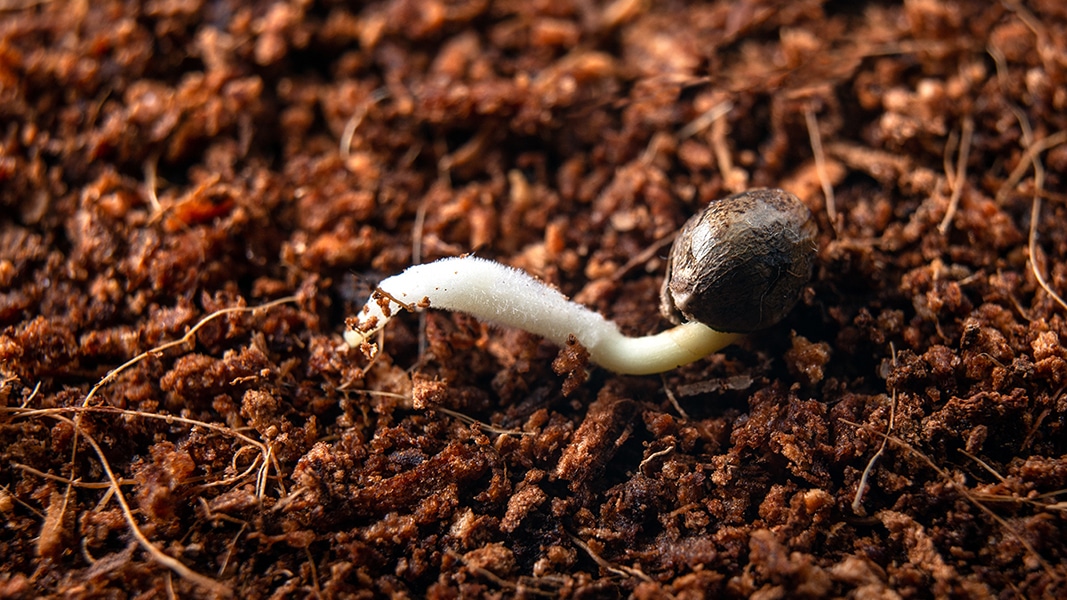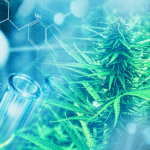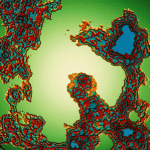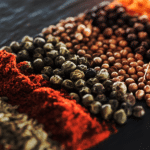It has long been known that resinous cannabis flower tops are well endowed with medicinal components. But that’s not the only part of the plant that has been used for therapeutic purposes. Cannabis roots have also provided relief for various ailments in traditional cultures.
The first mention of the curative qualities of cannabis roots dates back to 77 AD, as described in the Natural Histories by Latin naturalist Pliny the Elder.1 Since then, cannabis roots have been utilized by herbalists and physicians not only in Europe, but in many regions stretching from China to Argentina. Hemp roots were valued for treating a wide range of conditions, including fever, infections, gout, arthritis, joint pain, and even postpartum haemorrhage.2
Scientists are just beginning to recognize the healing properties of cannabis roots, which have largely been ignored both in research and in modern medical practice. The roots don’t contain aromatic essential oils and cannabinoids, such as THC and CBD, which are concentrated in the plant’s tiny glandular trichomes on the flower buds. Instead, the roots are imbued with other compounds that may have significant therapeutic applications.3
In this article, we examine where the latest science and the historical evidence are starting to merge.
Inflammation
Cannabis roots are rich in triterpenoids such as friedelin and its derivate epifriedelinol. Both compounds are abundant in nature and are known to have significant anti-inflammatory activity.4-7
Friedelin is found in many plants, such as citrus and rhododendron, as well as in algae, lichen, coal, and mineral wax. Friedelin is also present in cork and the bark of oak trees.8,9 Along with several other compounds in the roots of cannabis, friedelin has shown potent anti-inflammatory activity in in vivo experiments, reducing edema and swelling in any area of the body tested.10
In order to target overactive inflammation, cannabis root historically has been administered as a topical preparation — following a boiled water extraction or decoction. This method of extraction involves boiling herb or plant material and dissolving the chemical components to make a tincture, poultice or tea. Decoction is the name for the resulting liquid, which can be applied to the skin or consumed internally.
There are several reports of the use of cannabis roots as a treatment for inflammation. The earliest dates back to the 17th century in Culpeper’s Compleat Herbal by English physician and herbalist Nicholas Culpeper.11 In 1640, another English botanist, John Parkinson, described hemp as “cold and dry” and he recommended “a decoction of the root to cool inflammation of the head or any other part.”12
This cooling, anti-inflammatory property was confirmed by Dr. William Salomon in his personal notes (1710) and by Dr. Robert James in the book Pharmacopoeia Universalis (1747), and later by Husain Khan, who wrote in an 18th century Persian medical text: “A poultice of the boiled root and leaves is used for inflammations, and cure of neuralgic pains.”13,14
Pain & Skin Burns
At a lower concentration, the roots of cannabis contain monoterpenes, such as carvone and dihydrocarvone, which mainly show analgesic effects.15 Carvone and dihydrocarvone are the monoterpenes that give spearmint its distinct aroma and modulate the TRPM8 ionotropic receptor, which is sensitive to cooling and pain.16 Carvone’s antinociceptive activity has been confirmed by several in vivo tests, and that is why spearmint essential oil, which contains up to 70% of carvone, is currently under investigation as a treatment for ostheoarthritis.17
Other compounds identified in cannabis roots include sterols like B-sitosterol and campesterol and P-hydroxy-trans-cinnamamide, which was tested in vivo and also showed significant analgesic activity.18
Historical accounts indicate that cannabis roots have been administered topically to treat gout and arthritis — usually by extracting the compounds from the root in boiling water. During the Renaissance, the French physician Francois Rabelais noted that “the root of hemp, boiled in water, soothes muscles, stiff joints, gout pains and rheumatism.”19 In the early 18th century, the English physician William Salmon wrote that “the decoction of the hemp root eases the pains of the gout, helps hard tumours or knots of the joints, cramps, shrinking of the sinews, and [eases] sciatic pain in the hip. The application must be re-applied every day.”20
Cannabis preparations, made by pounding the raw root into a juice and mixing it with fat, have been used topically to soothe skin burns. In 1542, the German physician Leonard Fuchs wrote of hemp: “the raw root, pounded and wrapped, is good for the burn.”21
In 1640, Parkinson described the qualities of hemp as “cold and dry” and, in addition to recommending it for inflammation, noted that “the decoction of the root and the fresh juice mixed with oil or butter [is] good for any place that had been burnt by fire.” And in 1758, the French author Mercandier wrote about hemp in Traitè du Chanvre, indicating that the root ‘‘pounded and ground fresh, with butter in a mortar, one applies it to burns, which it soothes infinitely, provided it is often renewed.”22
Fever
As above previously, cannabis roots contain a high concentration of friedelin, an anti-inflammatory compound, which also has been researched for its antipyretic (fever-reducing) properties. When tested on animals, friedelin caused a significant reduction of internal body temperature comparable to the effects of paracetamol, a commonly used antipyretic drug.
In the Canon of Medicine, the 12th century medical encyclopedia written by the Persian philosopher Ibn Sina (known as Avicenna in Latin), the antipyretic properties of cannabis roots are discussed. Ibn Sina observes that “the compress with the boiled roots of cannabis decreases fever.”23
In Argentina, hemp roots have been used both topically and orally for treating fever.24
Childbirth & Postpartum Care
It appears that friedelin may also have estrogenic activity. Experiments have shown that administering 75 to 100 mg/kg of friedelin to female rats (with their ovaries removed) improved sexual behavior parameters and the estrogenic activity of the animals.25
Friedelin is one of the main compounds present in Cissus quadrangularis, an edible plant commonly found in India, Sri Lanka, Java and West Africa. This plant is used in Ayurvedic medicine as an aphrodisiac.
Maytenus ilicifoli, widely known throughout South America as Espinheira santa, also contains friedelin and is a well-known herbal remedy for stimulating menstruation and for balancing estrogen during menopause. Traditionally brewed in a tea, the leaves of this healing herb botanical are also valued for their anticancer properties in Brazil, where friedelin-infused ointments are applied topically for symptomatic relief.26
A scientific anaylsis of friedelin extracted from the bark of Mesua daphnifolia, a ubiquitous tree in Malaysia, showed cytotoxic activity against various women-specific malignancies, including breast cancer, cervical carcinoma and ovarian cancer cell lines.27
Cannabis roots also contain lignans. Molecules that belong to the lignan class include several unique cannabisin compounds (of the types A-, B-, C-, D-, E-, F-, and G), which don’t exist anywhere else in the botanical world. Lignans, in general, are noteworthy antioxidants that promote health by acting through antiviral, antidiabetic, antitumoral, and anti-obesity channels. The structural similarity of lignans and mammalian estrogens underscore the potential efficacy of this class of compounds for combating some hormone-dependent cancers and for breast cancer prevention.28
Practitioners of Chinese medicine have utilized preparations from cannabis roots to aid women during and after pregnancy. To assist with difficult childbirth, cannabis root is administered orally, either as juice or a decoction.29
In the ancient Chinese pharmacopeia (Pên-ts’ao Ching), there are references to the therapeutic use of hemp roots for obstetric issues: ‘‘The juice of the root is thought to have a beneficial action in retained placenta and postpartum hemorrhage.’’30 Other accounts from China report that the root of the hemp plant “dispels stasis and stanches bleeding. It is used in the treatment of flooding and spotting, vaginal discharge, difficult delivery and retention of the placenta. It is taken orally, either as a decoction or crushed to extract its juice (in its fresh form).”
Methods of Administration
To review — there are various traditional methods of preparing cannabis root for therapeutic use. The main route of administration has been via topical application. Fresh ground up root, juice, or cannabis root decoction were mixed with fat (oil or butter) for topical applications of cannabis root-based preparations.
- Topically: Raw cannabis root can be applied directly after pounding and crushing the fresh root to extract its juices. Throughout the 17th and 18th centuries, there are also many references to using cannabis root preparations with dried material. One account refers to mixing pulverised cannabis root with wine.
- Orally: To assist with difficult childbirth, cannabis root was administered orally, either as juice or decoction. As a remedy for infection, raw cannabis root has been administered topically, orally, and even rectally to treat animals.
Roots Action
The biological activity of cannabis roots hasn’t been studied clinically, and most of our current scientific understanding comes from preclinical research involving the same molecules found in cannabis roots and in other plants. In addition, cannabis roots contain small quantities of alkaloids — mainly cannabisativine and anhydrocannabisativine — that are exclusive to cannabis, but these have yet to be the focus of any basic research. Within cannabis roots, there are also residues of atropine and nerine, as well as choline, which isn’t an alkaloid but is very important for the formation of acetylcholine, lipid bilayers, and cellular signalling.31,32
Final thought: Cannabis roots can draw heavy metals from the soil, including iron, chromium, and cadmium.33 This bioaccumulative quality makes cannabis a great tool for phytoremediation (restoring the soil), but it undermines the therapeutic use of cannabis unless the source of the medicine is carefully considered. Contaminated soil can produce toxic roots and harmful plants, which should be scrupulously avoided.
Viola Brugnatelli, a Project CBD contributing writer, is the science director of cannabiscienza.it and a lecturer on cannabis therapeutics at the University of Padua, Italy. Project CBD is a U.S. ambassador for IACM, which publishes a weekly summary of medical science reports on cannabis therapeutics in several languages. Copyright, Project CBD. May not be reprinted without permission.
Footnotes
- Pliny (the Elder). The natural history of Pliny, Volume 4; Bohn’s classical library The natural history of Pliny. Translated by John Bostock, Henry Thomas Riley. H.G. Bohn: 1856;XX;298.
- Ryz, Natasha R., David J. Remillard, and Ethan B. Russo. “Cannabis roots: a traditional therapy with future potential for treating inflammation and pain.” Cannabis and cannabinoid research 2.1 (2017): 210-216.
- Lawrence RH, Waller GR. Glandular structures of Cannabis sativa L. and cannabinoid production. Plant Physiol. 1974;53:5–13.
- Slatkin DJ, Doorenbos NJ, Harris LS, et al. Chemical constituents of Cannabis sativa L. root. J Pharm Sci. 1971;60:1891–1892.
- Russo EB, Marcu J. Cannabis pharmacology: the usual suspects and a few promising leads. Adv Pharmacol. 2017;79:68.
- Sethi VK, Jain MP, Thakur RS. Chemical investigation of wild Cannabis sativa L. roots. Planta Med. 1977;32:378–379.21.
- Andre CM, Hausman JF, Guerriero G. Cannabis sativa: the plant of the thousand and one molecules. Front Plant Sci. 2016;7:19.
- Chandler RF, Hooper SN. Friedelin and associated triterpenoids. Phytochemistry. 1979;18:711–724.
- Pereira, H. (1988). Chemical composition and variability of cork from Quercus suber L. Wood Science and Technology, 22(3), 211-218.
- Antonisamy P, Duraipandiyan V, Ignacimuthu S, et al. Anti-diarrhoeal activity of friedelin isolated from Azima tetracantha Lam. in Wistar rats. South Ind J Biol Sci. 2015;1:34–37.
- Culpeper N. Culpeper’s complete herbal: consisting of a comprehensive description of nearly all herbs with their medicinal properties and directions for compounding the medicines extracted from them. W. Foulsham: London, 1994;xii:430.
- Parkinson J.Theatrum botanicum: The theater of plants; or, anherbal of a large extent.distributed into sundry classes or tribes, for the more easie knowledge of the many herbes of one nature and property, with the chiefe notes of Dr. Lobel, Dr. Bonham, and others inserted therein. Tho. Cotes: London, 1640.
- James R. Pharmacopoeia universalis: or, A new universal English dispensatory. Hodges & Wood: London, 1747;31:836.
- O’Shaughnessy WB. On the preparations of the Indian hemp, or Gunjah: Cannabis indica their effects on the animal system in health, and their utility in the treatment of tetanus and other convulsive diseases. Prov Med J Retrosp Med Sci. 1843;5:363–369.
- Goncalves JC, Oliveira Fde S, Benedito RB, et al. Antinociceptive activity of (-)-carvone: evidence of association with decreased peripheral nerve excitability. Biol Pharm Bull. 2008;31:1017–1020.
- Calixto, J. B., Kassuya, C. A. L., Andre, E., and Ferreira, J. (2005) Contribution of natural products to the discovery of the transient receptor potential (TRP) channels family and their functions. Pharmacol. Ther. 106, 179−208.
- Mahboubi M. Mentha spicata as natural analgesia for treatment of pain in osteoarthritis patients. Complement Ther Clin Pract. 2017;26:1–4.
- Slatkin DJ, Knapp JE, Schiff PL, et al. Steroids of Cannabis sativa root. Phytochemistry. 1975;14:580–581.
- Rabelais F. Gargantua and Pantagruel, 1st ed. Norton: New York, 1990;xi:623.
- Salmon W. Botanologia. The English herbal: or, history of plants. I. Dawkes: London, 1710.
- Meyer FG, Trueblood EWE, Heller JL, et al. The great herbal of Leonhart Fuchs: De historia stirpium commentarii insignes, 1542 [notable commen- taries on the history of plants]. Stanford University Press: Stanford, CA, 1999.
- Marcandier M. [Hemp Treaty]. In French. Chez Nyon: Paris, 1758;138.
- Ibn Sina A. Kanun fi at-Tibb (Canon of medicine) [in Arabic]. 2nd vol. Manuscript from the collection of the Institute of Manuscripts: Baku, Azerbaijan, copied 1143.
- Manfred L. Siete mil recetas botanicas a base de mil trescientas plantas medicinales. Editorial Kier S.A.: Buenos Aires, Argentina, 2008.
- Aswar UM, Bhaskaran S, Mohan V, et al. Estrogenic activity of frie- delin rich fraction (IND–HE) separated from Cissus quadrangularis and its effect on female sexual function. Pharmacognosy Res. 2010;2: 138–145.
- Queiroga CL, Silva GF, Dias PC, et al. Evaluation of the antiulcerogenic activity of friedelan-3beta-ol and friedelin isolated from Maytenus ilicifolia (Celastraceae). J Ethnopharmacol. 2000;72:465–468.
- Ee GC, Lim CK, Rahmat A, et al. Cytotoxic activities of chemical constituents from Mesua daphnifolia. Trop Biomed. 2005;22: 99–102.
- Ingram, David et al. “case-control study of phyto-oestrogens and breast cancer”. The Lancet 350.9083 (1997): 990-994.
- Brand E, Wiseman N. Concise Chinese Materia Medica. Paradigm Publications: Taos, NM, 2008.
- Smith FP, Stuart GA. Chinese materia medica; vegetable kingdom. American Presbyterian Mission Press: Shanghai, China, 1911.
- Elsohly MA, Turner CE, Phoebe CH, Jr, et al. Anhydrocannabisativine, a new alkaloid from Cannabis sativa L. J Pharm Sci. 1978;67:124.
- Turner CE, Hsu MH, Knapp JE, et al. Isolation of cannabisativine, an alkaloid, from Cannabis sativa L. root. J Pharm Sci. 1976;65:1084–1085.
- Irshad M, Ahmad S, Pervez A, et al. Phytoaccumulation of heavy metals in natural plants thriving on wastewater effluent at Hattar industrial estate, Pakistan. Int J Phytoremediation. 2015;17:154–158.










